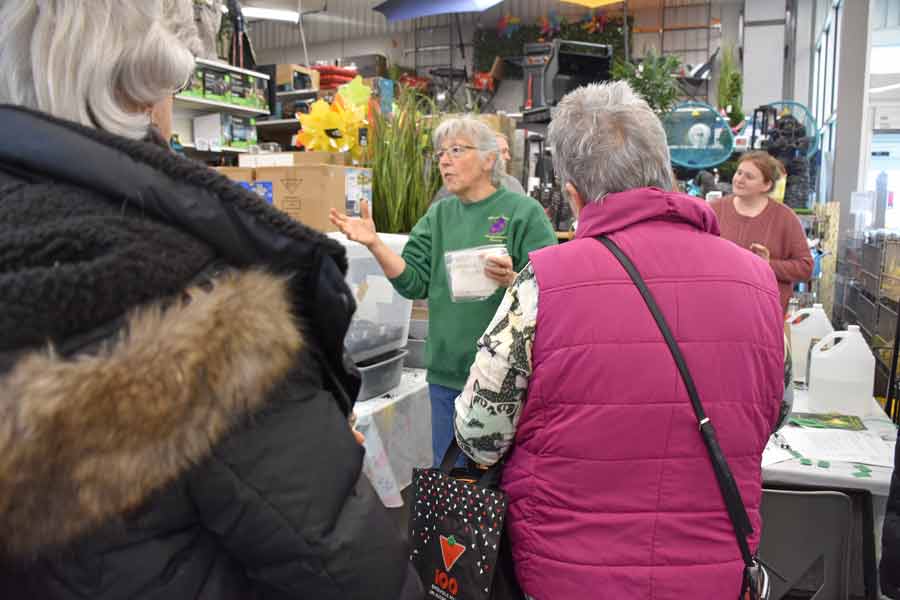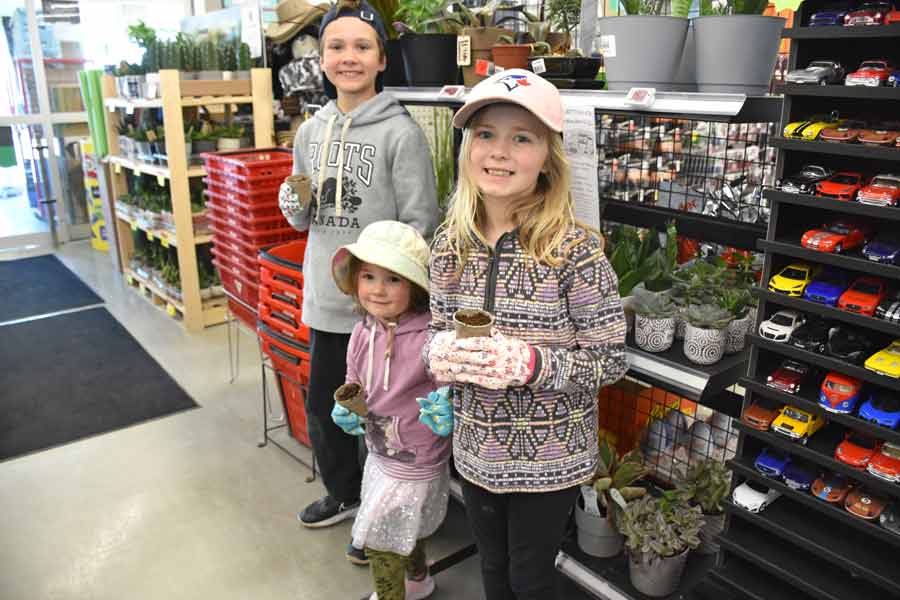MOUNT FOREST – Just in time for planting, the Mount Forest Horticultural Society held a workshop at Canadian Tire on April 6 to offer tips and tricks for gardeners.
Collette McTavish talked about preparing soil, how to start seeds indoors, how to harden the seedlings off when it’s time, and finally, planting seedlings in the ground. Every year is an experiment in the garden, she said, which is why it’s a good idea to keep a gardening journal.
“Then you know what does better,” she said.
Record things like what you planted, when you planted, how you prepared the soil, and significant weather events that might affect your crop, like late frost, lots of rain or no rain. And then record how each plant performed over the season and what your yield was like.
People generally believe the long weekend in May is the safe time to plant in the landscape, but McTavish recommended waiting until the beginning of June to put seedlings in the ground, since late frosts are becoming the norm. This also gives the soil time to warm up, which is beneficial for plants.
Garden centres and nurseries often sell seedlings that are ready for planting. But if you want to grow from seeds, now is the time to get those started indoors, she said.
Your best resource is the seed package McTavish said. Seed packages tell how many weeks it takes the seed to germinate, and that will vary depending on the plant. Do the math to calculate when to plant your seeds indoors.The package will also tell you how deep to plant your seed. That will vary plant to plant as well.
Seedling containers
Although there are kits that can be purchased for this purpose, just about any container will do to start seeds indoors, McTavish said.
Yogurt cups, plastic take-out containers and margarine tubs are all good candidates as long as they are three inches deep. Poke holes in the bottom for drainage. It’s a good idea to wash your planting pot in a mild bleach solution to avoid disease.
Set your containers on a tray so you don’t get water and soil all over the place.
Soil
Use a fresh, sterile, bagged seed-starting mix and not a straight potting soil, garden bed mix or soil from the garden.
Seed-starting soil is lighter and less dense than the garden bed options and will be easier for the seeds to penetrate the earth. Label your plants once they are planted.
Bright light
Seedlings need at least 12 hours of sunlight a day – 16 to 18 hours is even better. So to simulate daylight, use a grow light or even just a lightbulb after seeds begin to sprout.
Start the light low and raise it as the plant grows. You want your seedling to be strong and bushy. If the light is insufficient or too far away, the plant will become leggy and may not transfer well to the garden.
Water
It is best to sow seeds into damp soil, so add a little water to the soil before putting seeds in the container. Soil should be the consistency of a wrung-out sponge.
Once planted, cover the plants with a clear plastic lid. This acts like a greenhouse, preventing the seeds from drying out and holding in some warmth. Water the surface with a spray bottle.
Once seeds are sprouting, remove the plastic cover and begin to water plants from below by pouring water in the tray.
Heat
The general rule for seed starting is to start warm but grow seeds cool.
A heat mat under your planting trays can help with germination. You can also put trays in warm areas like the top of your fridge.
Airflow and fans
Air movement helps stems become strong and also helps reduce the risk of disease, pests, fungus and damping off. You can create a gentle breeze for your plant babies with an oscillating fan. Gently running your hand over the plants can have a similar benefit.
Potting up
After a few weeks of germination, check your seedlings to see if roots are poking through the drainage hole. When that happens, it’s time to transfer them to a larger pot. Because the seedlings are larger, you can use a richer soil in the bigger pot.
Hardening off
Impatient gardeners might want to put their babies directly in the garden once they are big enough and the weather is right. But take the time to gradually introduce seedlings to the great outdoors.
Start them in a shady spot for a couple of hours each day and gradually move them to the sun for longer stretches of time. You will have to bring them inside overnight until the temperature stays above 10C.
Flowers in the vegetable garden
McTavish said there are great benefits to growing flowers in the vegetable garden. Flowers attract pollinators and nematodes that vegetables also need to produce their fruit. Flowers can also act as a decoy attracting bugs that would otherwise eat the vegetables.

Colleen McTavish, of the Mount Forest Horticultural Society, talked to participants about how to plant seeds indoors to get a jump on the gardening season. Photos by Joanne Shuttleworth
So consider starting flower seeds indoors as well. Nasturtium, marigolds, amaranth and sunflowers are good companion plants for the vegetable garden, as are herbs that also flower.
At the end of the season, collect seeds from crops that did well, store them in a cool, dry place over the winter (clearly labelled), and you’ll be ready to jump on the season next year.
The Mount Forest Horticultural Society meets on the second Thursday of the month at the Mount Forest and District Sports Complex. Membership is $10 for adults, $7 for students and $15 for a family.
Visit its Facebook page for more information.




